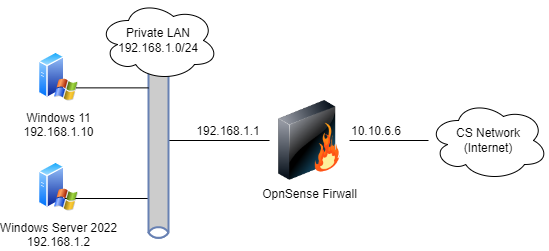|
Size: 1675
Comment:
|
Size: 1382
Comment:
|
| Deletions are marked like this. | Additions are marked like this. |
| Line 3: | Line 3: |
| {{{ NOTE: THERE HAS BEEN A CHANGE THE PROCEDURE BELOW! YOU NO LONGER NEED TO SETUP THE WHOLE SYSTEM SEE THE NEW DIRECTIONS }}} Below is a diagram that shows how your virtual network sees the world and how the world sees it. We have eliminated for the moment the complications of the <<latex($\mu$)>>Cloud. The IP address 216.249.119.123 is a place holder for your IP address. |
Below is a diagram that shows how your virtual network sees the world and how the world sees it. The IP address 10.10.4.X is a place holder for your IP address. |
| Line 11: | Line 7: |
| == New Instructions == First it is possible for you to use the old instructions, but the following procedure will make it easier. |
== Instructions == |
| Line 16: | Line 10: |
| 1. Using FileZilla or your favorite scp client and login to your server (use the Host=IP address, username=[name given in class] and port=22). | 1. Using !FileZilla or your favorite scp client and login to your server (use the Host=IP address, username=[name given in class] and port=22). |
| Line 18: | Line 12: |
| 1. On your linux machine issue the command: {{{ chmod u+x nat }}} | 1. On your linux machine issue the commands: a. {{{ chmod u+x nat }}} a. {{{ chmod u+x list }}} |
Virtual Network Configuration
Below is a diagram that shows how your virtual network sees the world and how the world sees it. The IP address 10.10.4.X is a place holder for your IP address.

Instructions
Using FileZilla or your favorite scp client and login to your server (use the Host=IP address, username=[name given in class] and port=22).
Upload the "nat" file you downloaded. (A real linux person would use wget or some such utility to get it directly from this site to your linux machine if you want try that instead

- On your linux machine issue the commands:
chmod u+x nat
chmod u+x list
Now run it ./nat -a [your ip address]
Your system is now setup! You can double check this by running ./list which shows the configuration changes that we just made. Of course you can always just look at the script to see what it did ;-}
Troubleshooting
So you may have noticed that there is already a nat script on your server. Well it does an extra thing that will cause trouble. If you ran that script you need to edit /etc/network/interfaces and remove the duplicate eth1 information.
